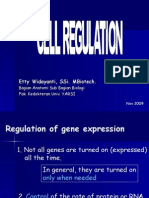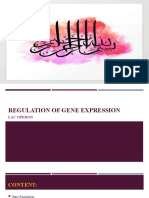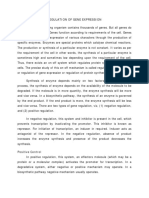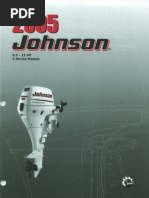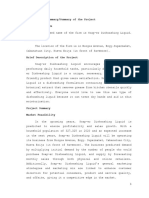0 ratings0% found this document useful (0 votes)
100 viewsAssignment 1 - Gene Regulation - Edpuzzle Video With Questions
The document discusses gene regulation in prokaryotes. It explains that some genes are expressed through transcription but not translation. It defines key terms like regulatory sequences, operons, and corepressors. It then describes the lac and trp operons as examples of positive and negative gene regulation. The lac operon induces expression of beta-galactosidase in the presence of lactose. The trp operon represses expression of tryptophan synthesis genes in the presence of tryptophan. Gene regulation in eukaryotes is more complex, involving transcription factors from outside the nucleus.
Uploaded by
Thuy DinhCopyright
© © All Rights Reserved
Available Formats
Download as DOCX, PDF, TXT or read online on Scribd
0 ratings0% found this document useful (0 votes)
100 viewsAssignment 1 - Gene Regulation - Edpuzzle Video With Questions
The document discusses gene regulation in prokaryotes. It explains that some genes are expressed through transcription but not translation. It defines key terms like regulatory sequences, operons, and corepressors. It then describes the lac and trp operons as examples of positive and negative gene regulation. The lac operon induces expression of beta-galactosidase in the presence of lactose. The trp operon represses expression of tryptophan synthesis genes in the presence of tryptophan. Gene regulation in eukaryotes is more complex, involving transcription factors from outside the nucleus.
Uploaded by
Thuy DinhCopyright
© © All Rights Reserved
Available Formats
Download as DOCX, PDF, TXT or read online on Scribd
You are on page 1/ 3
Assignment 1 - Gene Regulation - Edpuzzle video with questions
- "Express" a gene
+ Replicate a gene or in other words, make two copies of it.
*** Some genes do not code for proteins.
Example : A gene for rRNA will be expressed by being transcribed to RNA. But that
transcript will not be translated. So, technically, gene expression need not, in
some cases, lead to a protein being made.
- Terminology
+ A regulatory sequence (for example : a promoter,…) is found just "above" or
before a gene
+ An operon is a unit of DNA contain genes controlled by a promoter.
+ A corepressor is a molecule that cooperates with a repressor protein to switch
an operon off and binds allosterically to the site (for example : Tryptophan and
lactose) .
Prokaryotes and eukaryotes can alter enzyme production (gene expression) in
response to their environment.
- Operon
+ The lac operon (Positive control)
There are three genes, lac Z, Y and A, placed right next to each other (Each makes
protein and then breaks down the lactose). There is a regulatory sequence called the
promoter before them. In the middle of them is an operator, work as an on-off switch
with a repressor fit into.
No lactose present:
Because the operator is in off position, can’t make the gene.
Lactose present: Lactose fits in the repressor, changing the shape of the repressor,
makes it no longer fits in the operator
Because the operator is in on position, make gene: RNA polymerase can fit in the
promoter, making protein -> then those proteins will break down the lactose.
When the lactose gone, the repressor go back to its original shape, now the operator
is in off position.
*** So the purpose of the lac operon is so that the cell can metabolize lactose into
glucose (if short on glucose) and it does so by making and enzyme beta-
galactosidase which breaks lactose into glucose for glycolysis.
*** So the lac operon (remember this is bacteria in your system doing this)
induces gene expression for beta-galactosidase enzyme but is always OFF (called
an inducible operon) until the environment changes and the inducer - the lactose -
inactivates the repressor.
+ The trp operon (Negative control)
There are five genes, from trp A-trpE, placed right next to each other. Each makes
protein and then makes the tryptophan. There is a regulatory sequence called the
promoter before them. In the middle of them is an operator, work as an on-off switch
with a repressor fit into
Tryptophan present : Because the operator is in off position, can’t make the
gene.
No tryptophan present : the repressor changes shape
Because the operator is in on position, make gene : RNA polymerase can fit in the
promoter, making protein -> then those proteins will make tryptophan.
When tryptophan present, the repressor go back to its original shape, now the operator
is in off position.
- (Wrong answers) Correct statements about gene regulation :
1) lactose binds to the repressor, changing its shape (an allosteric interaction)
the presence of lactose inactivates the repressor
transcription can go ahead when the repressor is not bound to the operator
2) gene regulation in eukaryotes
+ more complex than in prokaryotes
+ involve transcription factors from outside the nucleus
You might also like
- Regulation of Gene Expression in Prokaryotic and Eukaryotic Cells0% (1)Regulation of Gene Expression in Prokaryotic and Eukaryotic Cells13 pages
- (MCB 311) Gene Expression and RegulationNo ratings yet(MCB 311) Gene Expression and Regulation21 pages
- 5 Molecular Mechanisms of Gene RegulationNo ratings yet5 Molecular Mechanisms of Gene Regulation44 pages
- Gene Regulation - The Lac Operon: Second Chance MissyplicityNo ratings yetGene Regulation - The Lac Operon: Second Chance Missyplicity8 pages
- Key Gene Regulation of Bacteria Operon SystemsNo ratings yetKey Gene Regulation of Bacteria Operon Systems2 pages
- 5. Overview, Gene regulation in bacteriaNo ratings yet5. Overview, Gene regulation in bacteria35 pages
- generegulationinprokaryotes_lacoperonfinal1 (1)No ratings yetgeneregulationinprokaryotes_lacoperonfinal1 (1)22 pages
- Regulation of gene expression in prokaryotesNo ratings yetRegulation of gene expression in prokaryotes26 pages
- Lecture # 13 (Gene Regulation in Prokaryotes - Lac Operon)No ratings yetLecture # 13 (Gene Regulation in Prokaryotes - Lac Operon)25 pages
- Prokaryotic and Eukaryotic Gene RegulationNo ratings yetProkaryotic and Eukaryotic Gene Regulation35 pages
- 220 GRQ 12 - Regulation of Gene Expression in ProkaryotesNo ratings yet220 GRQ 12 - Regulation of Gene Expression in Prokaryotes3 pages
- Gene Regulation: Jssansebastian@dlsud - Edu.phNo ratings yetGene Regulation: Jssansebastian@dlsud - Edu.ph13 pages
- Gono Bishwabidyalay: Department of MicrobiologyNo ratings yetGono Bishwabidyalay: Department of Microbiology15 pages
- BIO 1400 Topic 12 Regulation of Gene expression_2023No ratings yetBIO 1400 Topic 12 Regulation of Gene expression_20234 pages
- 5. Gene Regulation (Trp Operon) StudentNo ratings yet5. Gene Regulation (Trp Operon) Student11 pages
- Key Gene Regulation of Bacteria Operon SystemsNo ratings yetKey Gene Regulation of Bacteria Operon Systems2 pages
- Topic 9 Regulation of Gene Expression in Bacteria and Their Viruses - PART 1 0223No ratings yetTopic 9 Regulation of Gene Expression in Bacteria and Their Viruses - PART 1 022328 pages
- The Process and Purpose of Gene Expression RegulationNo ratings yetThe Process and Purpose of Gene Expression Regulation24 pages
- Sample Theory - CSIR NET LS (Post Transcription Modification) (UNIT-3)No ratings yetSample Theory - CSIR NET LS (Post Transcription Modification) (UNIT-3)26 pages
- The Basics of Cell Life with Max Axiom, Super Scientist: 4D An Augmented Reading Science ExperienceFrom EverandThe Basics of Cell Life with Max Axiom, Super Scientist: 4D An Augmented Reading Science ExperienceNo ratings yet
- Uninterruptible Power Supply Ups7000hx PDFNo ratings yetUninterruptible Power Supply Ups7000hx PDF10 pages
- Unit 4: Qualities of A Good Test: Validity, Reliability, and UsabilityNo ratings yetUnit 4: Qualities of A Good Test: Validity, Reliability, and Usability18 pages
- Jklp59yqi.2005.Johnson.4 Stroke.9.9.15HP - Outboards.service - Manaual75% (4)Jklp59yqi.2005.Johnson.4 Stroke.9.9.15HP - Outboards.service - Manaual264 pages
- Electromagnetic Braking and Its Applications100% (1)Electromagnetic Braking and Its Applications2 pages
- How To Lose Weight Through Calories DeficitNo ratings yetHow To Lose Weight Through Calories Deficit5 pages
- Category-Wise Opening & Closing Rank-Ayur - BHU Int.No ratings yetCategory-Wise Opening & Closing Rank-Ayur - BHU Int.5 pages
- Farmakologi 1 11. Obat Diuretika: Apt. NUR ATIKAH, M.Sc. 2021No ratings yetFarmakologi 1 11. Obat Diuretika: Apt. NUR ATIKAH, M.Sc. 202120 pages
- Question Bank ICSE Class 10th English Julius CaesarNo ratings yetQuestion Bank ICSE Class 10th English Julius Caesar6 pages
- HIS and Digitalization Quarter One 2015 SS ChecklistNo ratings yetHIS and Digitalization Quarter One 2015 SS Checklist25 pages
- Engenharia Racional de Escherichia Coli para Produção de Alto Nível de RiboflavinaNo ratings yetEngenharia Racional de Escherichia Coli para Produção de Alto Nível de Riboflavina9 pages
- In Vitro Bioaccessibility and Antioxidant Properties of Edible Bird's Nest Following Simulated Human Gastro-Intestinal DigestionNo ratings yetIn Vitro Bioaccessibility and Antioxidant Properties of Edible Bird's Nest Following Simulated Human Gastro-Intestinal Digestion8 pages
- Employment Agreement - Arabic & English VersionNo ratings yetEmployment Agreement - Arabic & English Version3 pages






























